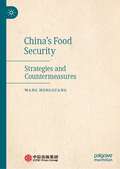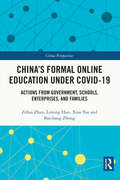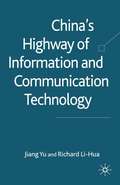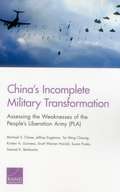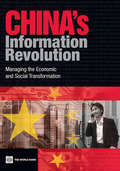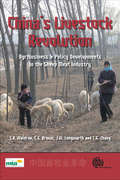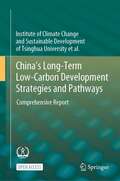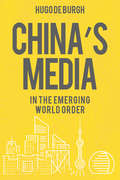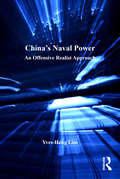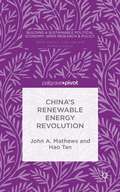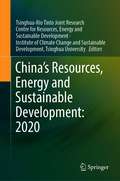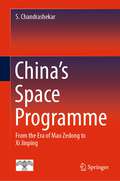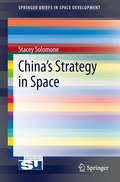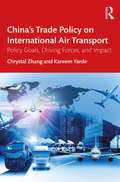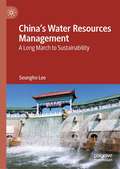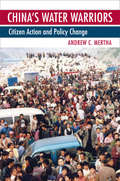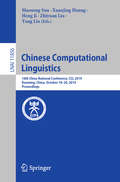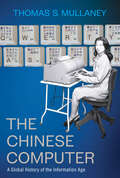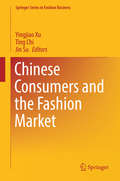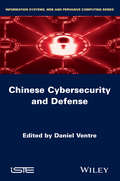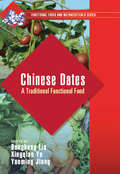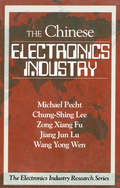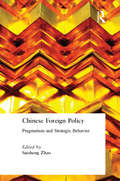- Table View
- List View
China's Food Security: Strategies and Countermeasures
by Wang HongguangThis book makes a systematic study of the history, current situation and trend of China's food security and the global food security. COVID-19 has triggered a world food crisis. Understanding the history, current situation and trend of China's and global food security is conducive to the rational arrangement of agricultural production, food storage, scheduling and import by management departments; it is conducive to the understanding of the situation of food supply and demand; it is conducive to the rational arrangement of production and operation planning. This book systematically studies the history and experience of China's food security, analyzes the 9 major problems facing the current food security, calculates the potential food production, puts forward the strategies and countermeasures for food security in the next 20 years and puts forward 4 strategies and 8 countermeasures for ensuring food security. This book will be of great value to scholars of international relations and sinologists, and has special relevance to United Nations sustainable development goal 2, eliminating hunger.
China's Formal Online Education under COVID-19: Actions from Government, Schools, Enterprises, and Families (China Perspectives)
by Zehui Zhan Liming Huo Xiao Yao Baichang ZhongThis book investigates how schools, enterprises and families in China have coped with the formal online education in the light of government policy throughout the COVID-19 epidemic outbreak, with special focus on the problems they have encountered and possible solutions. Using grounded theory, over 1000 posts retrieved from public online forums were analyzed under a 4*4 framework, referring to four special time nodes (proposal period, exploratory period, full deployed period, exiting period) and four major subjects (government, schools, enterprises, families). The book identifies four main issues faced by massive online education during the epidemic: platform selection in proposal period, teacher training in exploratory period, resource integration in full deployed period, and flexibility of returning to schools in exiting period. These findings enlighten us with a deeper understanding of the process of online learning in an educational emergency, helping to develop best countermeasures in similar situations, as well as to provide paths to follow for other countries. The book will appeal to teachers, researchers and school administrators of the online education and education emergency management, as well as those who are interested in Chinese education during the COVID-19 outbreak in general.
China’s Highway of Information and Communication Technology
by Jiang Yu Richard Li-HuaBased on first-hand information obtained from Chinese and Foreign enterprises and institutions in the Chinese ICT industry, this book presents a comprehensive analysis of the evolution of Chinese ICT industrial sector. It especially analyzes the strengths, weaknesses, and threats facing both the Chinese enterprise and western multinationals.
China's Incomplete Military Transformation: Assessing the Weaknesses of the People's Liberation Army (PLA)
by Michael S. Chase Jeffrey Engstrom Tai Ming Cheung Kristen A. Gunness Scott Warren Harold Susan Puska Samuel K. BerkowitzThrough extensive primary source analysis and independent analysis, this report seeks to answer a number of important questions regarding the state of China's armed forces. The authors found that the PLA is keenly aware of its many weaknesses and is vigorously striving to correct them. Although it is only natural to focus on the PLA's growing capabilities, understanding the PLA's weaknesses--and its self-assessments--is no less important.
China's Information Revolution
by Christine Zhen-Wei Qiang Christine Zhen-WeiSince 1997, China has devoted considerable resources to information and communications technology (ICT) development. China has the world's largest telecommunications market, and its information technology industry has been an engine of economic growth-growing two to three times faster than GDP over the past 10 years. E-government initiatives have achieved significant results, and the private sector has increasingly used ICT for production and service processes, internal management, and online transactions. The approaching 10-year mark provides an excellent opportunity to update the policy to reflect the evolving needs of China's economy. These needs include the challenges posed by industrialization, urbanization, upgraded consumption, and social mobility. Developing a more effective ICT strategy will help China to achieve its economic and social goals. Addressing all the critical factors is complex and requires long-term commitment. This book highlights several key issues that need to be addressed decisively in the second half of this decade, through policies entailing institutional reform, to trigger broader changes. This books is the result of 10 months of strategic research by a World Bank team at the request of China's State Council Informatization Office and the Advisory Committee for State Informatization. Drawing on background papers by Chinese researchers, the study provides a variety of domestic perspectives and local case studies and combines these perspectives with international experiences on how similar issues may have been addressed in other countries.
China’s Innovation Challenge
by Johann Peter Murmann Martin Kenney Arie Y. Lewin Lewin Arie Y. Kenney Martin Murmann Johann PeterThe miracle growth of the Chinese economy has decreased from a compound annual growth rate of 10% to less than 7% in 2015. The two engines of growth - export on a scale never before witnessed and massive infrastructure investments - are reaching the point of diminishing returns. This poses the central question which is explored in this book - can China escape the middle-income trap? Assuming current political arrangements remain unchanged and that it does not or cannot adopt Western sociopolitical economic regimes, can China develop an indigenous growth model centered on innovation? This compilation gathers leading Chinese and other international scholars to consider the daunting challenges and complexities of building an innovation-driven Chinese growth model. Providing several comprehensive perspectives, it examines key areas such as the institutional system, technology, sociocultural forces and national policy. The analyses and their conclusions range from strong optimism to deep pessimism about China's future.
China's Livestock Revolution: Agribusiness and Policy Developments in the Sheep Meat Industry
by Scott Waldron Colin Brown John Longworth Zhang CungenThis book focuses on the growing sheep meat industry while drawing on associated research from other areas of the Chinese livestock section. Using this research, the authors use the sheep meat industry case study to illustrate the broader trends that apply more generally to the Chinese livestock sector, especially in the case of ruminant livestock.
China's Long-Term Low-Carbon Development Strategies and Pathways: Comprehensive Report
by Institute of Climate Change and Sustainable Development of Tsinghua University et al.This open access book introduces a multi-disciplinary and comprehensive research on China's long-term low-carbon emission strategies and pathways. After comprehensively considering China’s own socioeconomic conditions, policy design, energy mix, and other macro-development trends and needs, the research team has proposed suggestions on China’s low-carbon development strategies and pathways until 2050, with required technologies and policies in order to realize the goals of building a great modern socialist country and a beautiful China. These achievements are in conjunction with the climate goals set in the Paris Agreement alongside Global Sustainable Development. The authors hope that the research findings can serve as a reference for all sectors of Chinese society in their climate research efforts, offer support for the formulation and implementation of china’s national low-carbon development strategies and policies, and help the world to better understand China’s story in the general trend of global green and low-carbon development.
China's Media in the Emerging World Order: how they came to be a powerful new force in media (Internationalizing Media Studies)
by Hugo De BurghChina is challenging the mighty behemoths, Google and Facebook, and creating alternative New Media. 750 million people are active on its Social Mediascape and there are a billion mobile phones deploying the innovative apps with which the Chinese conduct their lives.Though late starters, already four of the world's leading New Media companies are Chinese. China's old media - television, newspapers, radio - challenge the established powers which were long thought unassailable, such as CNN and BBC. Produced in many languages on every continent, they are re-defining the agenda and telling the story in China's way, with not just news and documentary series but also entertainment. The world's biggest manufacturer of TV drama is now making its stories for export.China's Media tells you why and how. It investigates the Chinese media, their strengths and weaknesses and how they are different. from the West. This detailed and comprehensive guide aims to showcase their immense variety and diversity, and demonstrates how they came to be a powerful new force in the media world.
China's Naval Power: An Offensive Realist Approach (Corbett Centre for Maritime Policy Studies Series)
by Yves-Heng LimThe rapid modernization of the Chinese Navy is a well-documented reality of the post-Cold War world. In two decades, the People's Liberation Army Navy has evolved from a backward force composed of obsolete platforms into a reasonably modern fleet whose growth is significantly shaking the naval balance in East Asia. The rationale behind China's contemporary rise at sea remains, however, difficult to grasp and few people have tried to see how the current structure of the international system has shaped Chinese choices. This book makes sense of Chinese priorities in its naval modernization in a 'robust' offensive realist framework. Drawing on Barry Posen's works on sources of military doctrine, it argues that the orientation of Beijing's choices concerning its naval forces can essentially be explained by China's position as a potential regional hegemon. Yves-Heng Lim highlights how a rising state develops naval power to fulfil its security objectives, a theoretical perspective that goes farther than the sole Chinese case.
China's Path to Innovation
by Xiaolan FuOver the past three decades, China has experienced rapid economic growth and a fascinating transformation of its industry. However, much of this success is the result of industrial imitation and China's continuing success now relies heavily on its ability to strengthen its indigenous innovation capability. In this book, Xiaolan Fu investigates how China can develop a strategy of compressed development to emerge as a leading innovative nation. The book draws on quantitative and qualitative research that includes cross-country, cross-province and cross-firm analysis. Large multi-level panel datasets, unique survey databases, and in-depth industry case studies are explored. Different theoretical approaches are also used to examine the motivations, obstacles and consequences of China's innovation with a wider discussion around what other countries can learn from China's experience. This book will appeal to scholars and policy-makers working in fields such as innovation policy, technology management, development and international economics and China studies.
China’s Renewable Energy Revolution
by John A. Mathews Hao TanChina's formidable energy system, which has powered the nation's rise as workshop of the world and thereby lifted hundreds of millions of its people out of poverty, is undergoing dramatic changes. China's industrial transformation started, like that of all previous industrial powers, with extensive reliance on fossil fuels, principally coal for electric power and oil for transport. But China is now running into the limits of this fossil-fuelled expansion, both for reasons of immediate environmental degradation (unbreathable air), energy insecurity (imports from problematic parts of the world) as well as increasing international pressure over carbon emissions. An alternative has to be found. Mathews and Tan describe how an alternative is indeed being developed. Over the past decade China has been pursuing an alternative 'green' energy strategy that complements the better-known 'black' energy strategy based on burning fossil fuels. This has involved a much less widely discussed investment in expansion of power generating capacity utilizing renewable energy sources such as water, wind and solar making China by far the largest manufacturer, builder and utilizer of renewable power systems on the planet. "
China’s Resources, Energy and Sustainable Development: 2020
by Tsinghua-Rio Tinto Joint Research Centre for Resources, Energy and Sustainable Development Institute of Climate Change and Sustainable Development, Tsinghua UniversityThis book explores sustainable development from the perspective of resources and energy, based on China’s practical experience and cross-disciplinary research. It focuses on major challenges, key solutions and policy recommendations, and studies and explores seven important themes of resources, energy and sustainable development, including: 1) China’s low-carbon energy transition, 2) China’s urbanization and low-carbon development, 3) China’s low-carbon action in cities, 4) China’s low-carbon power transition, 5) China’s water resources management, 6) electric vehicle development and key metal resources and 7) China’s low-carbon development of the iron & steel industry. This book contributes to a more integrated understanding of many themes and their relationships in the area of resources, energy and sustainable development and guides the related policy and management.
China's Space Programme: From the Era of Mao Zedong to Xi Jinping
by S. ChandrashekarThis book comprehensively covers the history and current developments of space programme of China. It presents the complete story of China’s space programme from its origins through to present day activities on the International Space Station. This monograph further discusses the role of China’s space strategy in its emergence as a major power on the world stage. The book also presents the context of China’s space program within the larger narrative of international space development. The book binds together the diverse political, military, economic and technology aspects into a coherent understanding and explains their role in the establishment and growth of Chinese space programme. Given the contents, this book will be a valuable source of information for students, researchers, and historians in the area of space studies.
China’s Strategy in Space (SpringerBriefs in Space Development)
by Stacey SolomoneThis book addresses why China is going into space and provides up- to-date information on all aspects of the Chinese Space Program in terms of launch vehicles, launch sites and infrastructure, crew vehicles for space exploration, satellite applications and scientific exploration capabilities. Beyond mere capabilities, it is important to understand how Chinese aerospace leaders think, how they make decisions, and what their ultimate goal is during their space endeavors. What are Chinese intentions in space? To what extent does culture and ethics influence Chinese strategic decision-making within the highest levels of the aerospace industrial complex? This book examines these questions and offers four potential scenarios on where the Chinese space program is headed based on this new perspective of understanding China's space goals. This book is not only required reading for policy makers and military leaders in the US government, but also for the general population, students, and professionals interested in truly understanding the reasons behind what the Chinese are doing in space.
China’s Trade Policy on International Air Transport: Policy Goals, Driving Forces, and Impact
by Chrystal Zhang Kareem YardeThis book is a political–economic analysis of China’s transformation to become a global aviation power. It aims to identify the driving forces that have shaped China’s ever-evolving international air transport policy direction and goals in the past four decades and further determines how and to what extent these driving forces have shaped China’s considerations and strategies when executing its policy goals through bilateral air services negotiations. The findings reveal that China’s international air transport policymaking has remained in the domain of the country’s aviation regulator, which has enjoyed an exclusivity to exercise its power on the air transport sector. The book argues that China’s international air transport policy direction is in alignment with the country’s overall strategic mission and its goal is set to support the country’s endeavour to realise the “China dream.” It concludes that factors at all levels interact with each other with a far-reaching impact on the country’s policy direction and goal setting; however, these factors are constrained by time and circumstances. The book is a must-read for a wide array of audiences, including, but not limited to, scholars and industry professionals who have an interest in China’s political economy, policymaking, international trade, government behaviour, corporate political activities, air transport, aviation liberalisation, and bilateral negotiations.
China's Water Resources Management: A Long March to Sustainability
by Seungho LeeThis book investigates water resources management and policy in China over the last two decades with a core focus on the role of water for socioeconomic development and sustainability. Recent policies, such as the Three Red Lines and the Water Ten Plan are evaluated for sustainable water supply, use and quality control. The book appraises solutions through demand management, water rights and pollution trading, virtual water and water footprint. Supply management is discussed taking examples from the Three Gorges Dam and the South North Water Transfer Project. The water market is investigated uncovering the active engagement of the private sector and includes discussions on how transboundary rivers demonstrate China’s engagement with its riparian countries for benefit sharing. This book will be an invaluable reference for researchers in the field as well as practitioners and students who have an interest in water and development in China.
China's Water Warriors: Citizen Action and Policy Change
by Andrew C. MerthaToday opponents of large-scale dam projects in China, rather than being greeted with indifference or repression, are part of the hydropower policymaking process itself. What accounts for this dramatic change in this critical policy area surrounding China's insatiable quest for energy? In China's Water Warriors, Andrew C. Mertha argues that as China has become increasingly market driven, decentralized, and politically heterogeneous, the control and management of water has transformed from an unquestioned economic imperative to a lightning rod of bureaucratic infighting, societal opposition, and open protest. Although bargaining has always been present in Chinese politics, more recently the media, nongovernmental organizations, and other activists--actors hitherto denied a seat at the table--have emerged as serious players in the policy-making process. Drawing from extensive field research in some of the most remote parts of Southwest China, China's Water Warriors contains rich narratives of the widespread opposition to dams in Pubugou and Dujiangyan in Sichuan province and the Nu River Project in Yunnan province. Mertha concludes that the impact and occasional success of such grassroots movements and policy activism signal a marked change in China's domestic politics. He questions democratization as the only, or even the most illuminating, indicator of political liberalization in China, instead offering an informed and hopeful picture of a growing pluralization of the Chinese policy process as exemplified by hydropower politics. For the 2010 paperback edition, Mertha tests his conclusions against events in China since 2008, including the Olympics, the devastating 2008 Wenchuan earthquake, and the Uighar and Tibetan protests of 2008 and 2009.
Chinese Computational Linguistics: 18th China National Conference, CCL 2019, Kunming, China, October 18–20, 2019, Proceedings (Lecture Notes in Computer Science #11856)
by Maosong Sun Xuanjing Huang Heng Ji Zhiyuan Liu Yang LiuThis book constitutes the proceedings of the 18th China National Conference on Computational Linguistics, CCL 2019, held in Kunming, China, in October 2019. The 56 full papers presented in this volume were carefully reviewed and selected from 134 submissions. They were organized in topical sections named: linguistics and cognitive science, fundamental theory and methods of computational linguistics, information retrieval and question answering, text classification and summarization, knowledge graph and information extraction, machine translation and multilingual information processing, minority language processing, language resource and evaluation, social computing and sentiment analysis, NLP applications.
The Chinese Computer: A Global History of the Information Age
by Thomas S. MullaneyThe fascinating, untold story of how the Chinese language overcame unparalleled challenges and revolutionized the world of computing.A standard QWERTY keyboard has a few dozen keys. How can Chinese—a language with tens of thousands of characters and no alphabet—be input on such a device? In The Chinese Computer, Thomas S. Mullaney sets out to resolve this paradox, and in doing so, discovers that the key to this seemingly impossible riddle has given rise to a new epoch in the history of writing—a form of writing he calls &“hypography.&” Based on fifteen years of research, this pathbreaking history of the Chinese language charts the beginnings of electronic Chinese technology in the wake of World War II up through to its many iterations in the present day.Mullaney takes the reader back through the history and evolution of Chinese language computing technology, showing the development of electronic Chinese input methods—software programs that enable Chinese characters to be produced using alphanumeric symbols—and the profound impact they have had on the way Chinese is written. Along the way, Mullaney introduces a cast of brilliant and eccentric personalities drawn from the ranks of IBM, MIT, the CIA, the Pentagon, the Taiwanese military, and the highest rungs of mainland Chinese establishment, to name a few, and the unexpected roles they played in developing Chinese language computing. Finally, he shows how China and the non-Western world—because of the hypographic technologies they had to invent in order to join the personal computing revolution—&“saved&” the Western computer from its deep biases, enabling it to achieve a meaningful presence in markets outside of the Americas and Europe.An eminently engaging and artfully told history, The Chinese Computer is a must-read for anyone interested in how culture informs computing and how computing, in turn, shapes culture.
Chinese Consumers and the Fashion Market (Springer Series in Fashion Business)
by Yingjiao Xu Ting Chi Jin SuThis book provides essential insights into Chinese consumer behaviors in the growing and dynamic fashion market. With increasing consumer purchasing power, readily accessible global brands, heavy application of digital technology and social media, as well as growing awareness of environmental issues, the Chinese fashion industry faces great opportunities and challenges at the same time. The contributing authors provide observations and address issues related to middle class fashion consumption, sustainable apparel consumption, technology application in fashion retailing, and the select traditional and new industry segments in the context of China’s recent and massive economic boom. As such, the book offers an invaluable reference guide for all academics and practitioners interested in the Chinese fashion market.
Chinese Cybersecurity and Cyberdefense
by Daniel VentreCyberdefense has become, over the past five years, a major issue on the international scene. China, by the place it occupies, is the subject of attention: it is observed, criticized, and designated by many states as a major player in the global cyber-insecurity. The United States is building their cyberdefense strategy against what they call the "Chinese threat." It is therefore important to better understand today's challenges related to cyber dimension in regard of the rise of China.Contributions from international researchers provide cross perspectives on China, its strategies and policies for cybersecurity and cyberdefense. These issues have now gained major strategic dimension: Is Cyberspace changing the scene of international relations? How China does apprehend cybersecurity and cyberdefense? What are the issues, challenges? What is the role of China in the global cyberspace?
Chinese Dates: A Traditional Functional Food (Functional Foods And Nutraceuticals Ser.)
by Dongheng Liu; Xingqian Ye; Yueming JiangChinese Dates: A Traditional Functional Food delivers unique information on Chinese dates (jujubes) as typical ethical foods and traditional health-promoting foods. It conveys a better understanding of Asian food cultures and provides historical information in regard to traditional functional foods and their dietary applications. It discusses the h
The Chinese Electronics Industry
by Michael Pecht Chung-Shing Lee Wang Yong Wen Zong Xiang Fu Jiang Jun LuThe Chinese Electronics Industry documents the technologies, capabilities, and infrastructure that has made China a major player in the Asian electronics industry. This book covers the major segments of China's electronics industry, including semiconductors, packaging, printed circuit boards, computer hardware and software, telecommunications, and electronic systems. In addition, this book examines the role of government, research organizations, educational institutions, and major companies in establishing an infrastructure where the industry can flourish. Specifically, this book will help readers:Comprehend the historical developments, current status, and future growth of China's electronics industryUnderstand the cultural, economic, and technological factors that drive and inhibit market access and success in ChinaMake decisions on strategic issues, such as market entry, establishing joint ventures or strategic alliances with Chinese electronics companies in order to access world's largest emerging marketFormulate strategy to cooperate and compete in the global electronics industry
Chinese Foreign Policy: Pragmatism and Strategic Behavior
by Suisheng ZhaoThis volume explores how China is adapting to international norms and practices while still giving primacy to its national interests. It examines China's strategic behaviour on the world stage, particularly in its relationships with major powers and Asian neighbours.
